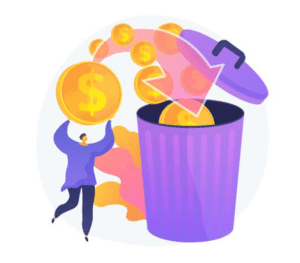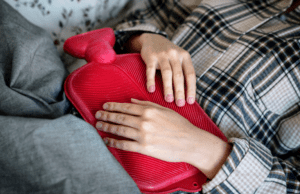Medically reviewed by Sophia Yen, MD, MPH – Written by Pandia Health Editorial Team. Updated on May 7, 2021

Periods will Cost you. It is not easy being a woman… Ever heard that before?
Well, here’s more…
Having a uterus is certainly not cheap – just having your period is expensive.
With about half of the world’s population undergoing this phenomenon monthly, most people aren’t aware of how much their periods will cost over a lifetime.
How many periods does a woman have in her lifetime?
Almost every person with a uterus on the planet gets a period, and the amount of time they spend on their period really adds up. The average woman menstruates from age 13 until age 51, about once a month, with each period lasting from three to seven days. All in all, this equals 456 periods over a span of 38 years, which amounts to roughly 6.25 years or 2,280 days of your life spent bleeding.
Cost of Hygiene Products
The list is endless – tampons, menstrual cups, sanitary pads, panty liners, period panties. These are a few of the menstrual hygiene items most women buy every month to survive one menstrual cycle. This is an unavoidable cost with getting your period. Ranging in different sizes, functions, and prices, these items are subject to tax (in many states, activists are working to get rid of the #tampontax/pink tax) and most of them cannot be safely reused. Assuming the prices of these sanitary items stay fixed, this is what you’re looking at:
Tampons
If one tampon is used every six hours and four tampons are used every day, you’re looking at 20 tampons for every five-day menstrual cycle totaling 9,120 tampons in your life. If one box costs $7, and there are 36 tampons per box, the cost for a lifetime equals $1,773.33. Don’t even get us started on the cost of the pricier organic tampons…
Panty liners
Panty liners are thin pads that are typically worn on days when bleeding is lighter (a.k.a at the beginning or end of your period). These have been estimated to average $443.33 per lifetime (5 panty liners per cycle, with each box of 36 costing $7).
Pads
Many women prefer to wear pads over tampons and/or menstrual cups, as they do not need to be inserted into the vagina and simply stick to your underwear. While prices can range, assuming you use three to five pads a day over a five-day period, you likely spend around $4,752 in their lifetime just on pads.
Ruined panties
Nearly all women leak during periods, sometimes causing permanent stains on underwear. If one ruined period panty costs $5, that equals $2,280 for 456 periods.
Menstrual cups & disks
Menstrual cups cost between $20-40 each and can last for 10 years if taken care of properly. With this in mind, a woman might spend at least $80 on menstrual cups during their lifetime. Period disks are also an option, although they can get quite expensive. Women usually use about 8 disks per cycle. Depending on the brand, a pack of 8-12 disks can cost between $10 and $20. Thus, a woman could end up spending at least $4,560 on disks. It is also important to note that the costs of cups and disks might be in addition to the cost of pads/panty liners, as many women use both at the same time to avoid leakage.
Cost of Period Care & Medications
Getting a period comes with numerous unpleasant side effects ranging from mild cramps to crippling abdominal pain. A 2012 study revealed that 25-50% of adult women and 75% of adolescents in developing countries experience menstruation pain with 20% reporting severe dysmenorrhea or pain that prevents them from participating in their usual activities. Some women have to be on bed rest loaded with pain relievers to get through one menstrual cycle. Menstruation also comes with a plethora of adverse symptoms like mood swings, sore breasts, pimples, bloating, cramps, digestive issues, muscle pain, headaches, and lack of concentration.
To combat these period symptoms, women have to resort to acne medication, painkillers, heating pads, hot water bottles, birth control, and several other contraceptives – all of which come with a cost.
Acne medication
The price of acne medication depends on the type and whether you have insurance or not. Your typical topical benzoyl peroxide gel goes for about $25 per tube. Over a span of 38 years, this equates to $11,400.
That was just the cost for benzoyl peroxide gel – many women also need to take antibiotics. Clindamycin is the most commonly prescribed antibiotic for acne. Pricing varies depending on insurance but without, the cost is $30 for a 30-day supply of a 150 mg capsule and $90 for the 300 mg. Fortunately, these are only prescribed for a limited amount of time.
Another popular form of acne medication is retinol. Tretinoin, a popular prescription, can cost about $42 per tube, which could last for a year if used sparingly. Thus, it is possible to spend $1,596 on this particular retinoid cream throughout your lifetime.
Painkillers
Period pains may be combated with Midol or any equivalent painkiller. At 12 caplets by 456 periods, this stacks up to 5,472 caplets amounting to $1,229.83 for a lifetime.
Heating pads & hot water bottles
Heating pads and hot water bottles are like a warm hug that can help relieve pain in the abdominal cramps. Heating pads might cost upwards of $20 each and hot water bottles are about $10 each! Ideally, one of either of these options should last forever, but let’s assume you buy 3 over your lifetime. For heating pads, that is at least $60 and for hot water bottles, that is at least $30.
Birth control
With the pill costing between $15 to $50 per month, this racks up to between $180 to $600 every year if you don’t have insurance or your insurance doesn’t cover your birth control. Throw in the annual visit to the OB-GYN and you are looking at an additional $800. With an average of $25/pack, birth control pills can cost a woman up to $11,400 in a lifetime.
Cost of Humiliation
In March 2018, the period tracker app, Clue, carried out a survey showing that 18% of US women have missed school, work or an event because they were afraid of someone finding out they were menstruating. In developing countries, access to toilets and sanitary hygiene products add to this problem, as many girls are forced to stay home from school during their periods. The cost of menstruating can be as grave as missing out on important life events.
Cost of Laundry
Periods come with an increased cost of laundry from stains and leaks. The only solution that has been proffered to deal with this resultant cost is changing tampons/sanitary products more frequently (which is already a costly expense). Having to change sheets and wash soiled clothes monthly can rack up your bills.
This extra money might not seem like much in the present, but an extra $5 for laundry every month for 456 periods could total up to $2,280.
Cost of Period Complications
Endometriosis
With periods comes disorders like endometriosis (a condition where the lining of the womb begins to grow outside the womb), which results in extremely heavy periods. This complication can ramp up your period cost by about $2,801 every year on medical care alone.
Cancer – Endometrial and Ovarian
Severe health issues such as endometrial and ovarian cancers can develop as a result of menstruation. Women who began menstruating before age 12 have a higher risk of developing these types of cancer. The only way to decrease your risk (except for taking out your ovaries!) is by taking birth control pills, which prevent the ovaries from popping out an egg each month.
PCOS
Polycystic ovary syndrome, or PCOS, is a hormonal imbalance of insulin and progesterone. This disorder affects how the ovaries function. Symptoms include irregular or no periods, excess androgen, acne, weight gain, infertility, and pelvic pain. While there is no cure for PCOS, it is often treated with some form of hormonal birth control. These methods decrease the number of cysts on the ovary by blocking ovulation (a.k.a the release of an egg).
PMS & PMDD
PMS or premenstrual syndrome refers to a pattern of physical, emotional, and behavioral symptoms that one or two weeks before your period. Symptoms include, but are not limited to bloating, increased appetite, headaches, muscle aches, fatigue, forgetfulness, and irritability.
PMDD or premenstrual dysphoric disorder is very similar to PMS but more severe. PMDD results in severe irritability, depression, or anxiety in the weeks leading up to a period. About 5% of women of reproductive age are affected by PMDD and some may even have anxiety or depression as a result of the intense symptoms.
There is no cure for either PMS or PMDD, but there are measures that can be taken to lessen their effects. Some treatments that may be implemented include monthly mood charting, lifestyle modifications (ie. lessening the intake of caffeine, sugar, and sodium), nutritional supplements (ie. calcium), herbal remedies, and/or psychotherapy. In more extreme cases, narcotics, hormonal intervention, and surgical intervention can also be used.
Amenorrhea
Amenorrhea is the absence of a period. There are two types: primary amenorrhea (when you have not had a period by 15 years old) and secondary amenorrhea (when you miss more than three periods in a row). Causes for both are most likely due to hormone levels or pregnancy (but only for secondary amenorrhea). In many cases, amenorrhea is due to lifestyle factors such as being overweight or underweight, undergoing high stress, or engaging in intense exercise. Primary amenorrhea caused by genetic problems can result in irregular development of the ovaries, which increases the risk for cancer. Treatments for amenorrhea varies by type, but it can include both medical or surgical interventions.
Dysmenorrhea
Dysmenorrhea refers to painful periods. The pain may start mild, but it can become severe enough to interfere with day-to-day life. There are two types of dysmenorrhea: primary (cramping pain before or during a period) and secondary (due to a disorder in reproductive organs. Dysmenorrhea is commonly treated with pain relievers such as ibuprofen but other methods may include birth control, acupuncture, and nerve stimulation.
What’s the takeaway
If you take one thing away from this, we hope you recognize that periods come with a cost – and not just in the form of money. Menstruation can take both a physical and emotional toll, making it a valid area of frustration for those who experience it throughout their life. With that said, people with uteri are not alone. The more we ban together to normalize our periods, the more likely we are to eventually find greater comfort.
Skip Your Period and Take Control of Your Menstrual Cycle Today!
Say goodbye to the inconvenience of your period! With birth control, you can skip your period and enjoy life uninterrupted. Order a prescription from Pandia Health and get it delivered to your door for FREE!
How can Pandia Health help you?
Periods are something that almost all people with uteri endure. Thankfully, it is possible to safely skip your period by taking birth control. Not only will this lead to physical benefits, but it could also greatly reduce your expenses. Learn more about how to make your #PeriodsOptional.
Disclaimer: The views expressed in this article intend to inform and induce conversation. They are the views of the author and do not necessarily represent the views of Pandia Health, and are for informational purposes only, even if and to the extent that this article features the advice of physicians and medical practitioners. This article is not, nor is it intended to be, a substitute for professional medical advice, diagnosis or treatment, and should never be relied upon for specific medical advice.



